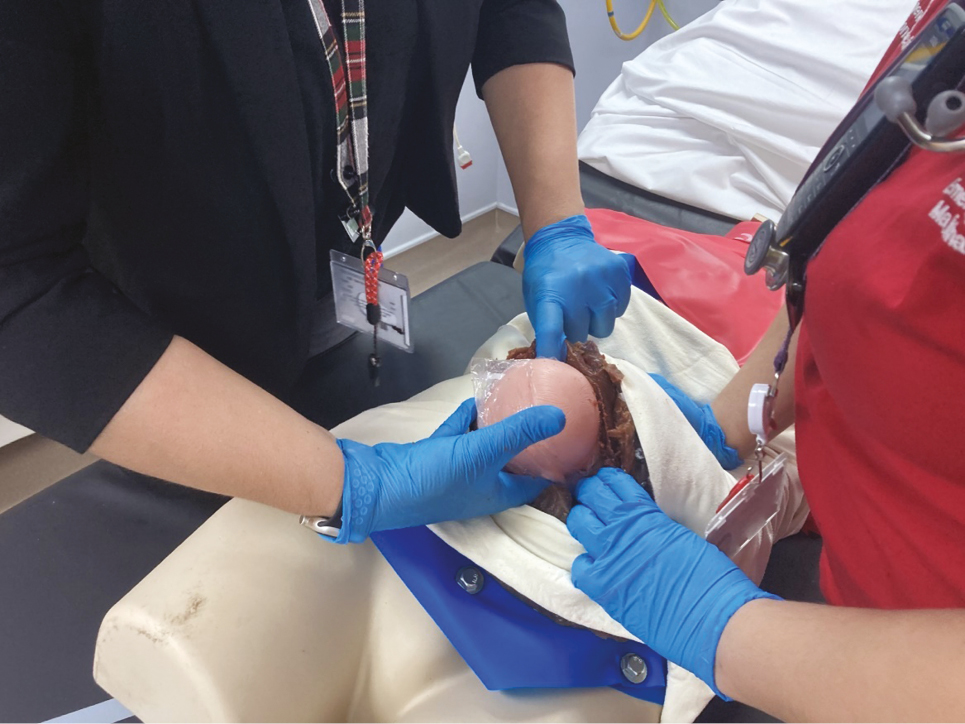
Maternal cardiac arrest is rare, with an incidence of 2.78 per 100 000 maternities in the UK [1]. RCOG guidelines state that if there is no response to CPR after 4 minutes, a perimortem caesarean section (PMCS) should be performed [2]. As part of University Hospitals Sussex NHS Foundation Trust’s (UHSx) new approach to patient safety, local instances of PMCS have prompted the development of a new, simulation-based, multi-disciplinary, transformative learning package [3]. “The ADAMgel Group” in collaboration with the local, pan-UHSx simulation, emergency medicine and obstetrics departments are developing a low-cost, procedurally accurate, and sustainable PMCS simulation model.
ADAMgel (Aqueous Dietary fibre Antifreeze Mix gel) was infused in a large stockinette and layered with chamois leather and velcro tape to reproduce the anatomical layers encountered when performing PMCS. This was fastened to a simple clothes mannikin frame in which we excised a fluid retaining cavity for our uterus model. A plastic doll in a watertight bag was used to simulate the foetus and amniotic sac. Foam pads were attached to the chest to allow simultaneous CPR, and a rocker bottom to enable a lateral decubitus position. This aims to add situational realism, and replicate known ergonomic issues and human factors.
Initial feedback from senior clinicians, experienced in the techniques, has been excellent. The procedural accuracy, fidelity to biological tissue and the capacity to simulate CPR were highlighted as particular successes (Figure 1-A120).
The ADAMgel layers can be recycled and re-used, in line with the UHSx “Planet First” sustainability policy. The fabric layers were either stitched back together for reuse or new Velcro tape was applied to reset the manikin. All the materials were low cost and readily available, and assembly was straightforward.
ADAMgel in combination with other readily available materials can produce an effective, low-cost, sustainable, and procedurally accurate PMCS model. This model, paired with appropriate speciality-specific learning resources and more generalised multi-disciplinary team centred learning outcomes, will enable high-acuity-low-occurrence (HALO) training in this procedure. Collaboration between different departments to share mental models, decision-restricting barriers and how an MDT can support decision-makers in this high-stress situation will be incorporated into the regular UHSx patient-safety based simulation program, ensuring our trust is prepared for these events. Further work to limit usage of non-recyclable materials will be needed to bring the model fully in-line with the ethical principles of the ADAMgel group.


Authors confirm that all relevant ethical standards for research conduct and dissemination have been met. The submitting author confirms that relevant ethical approval was granted, if applicable.
1. Beckett V, Knight M, Sharpe P. The <scp>CAPS</scp> Study: incidence, management and outcomes of cardiac arrest in pregnancy in the <scp>UK</scp>: a prospective, descriptive study. BJOG: An International Journal of Obstetrics & Gynaecology. 2017;124(9):1374–1381.
2. Chu J, Johnston T, Geoghegan J. Maternal collapse in pregnancy and the puerperium. BJOG: An International Journal of Obstetrics & Gynaecology. 2020;127(5).
3. Weldon SM, Buttery AG, Spearpoint K, Kneebone R. Transformative forms of simulation in health care – the seven simulation-based ‘I’s: a concept taxonomy review of the literature. International Journal of Healthcare Simulation. 2023.